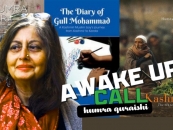-853X543.jpg)
Ten Years with Guru Dutt
by The Daily Eye News Desk October 21 2020, 12:00 am Estimated Reading Time: 11 mins, 8 secsTen Years with Guru Dutt, Abrar Alvi’s Journey is the behind-the-scenes story of Guru Dutt Films, written by Sathya Saran
The friendship that Guru Dutt and his writer and assistant director, Abrar Alvi, shared led to a collaboration that bore rich results. Abrar’s logical mind was the perfect foil to Guru Dutt’s creative genius.
Through the book Abrar Alvi reveals little known facts about his mentor and his approach to cinema besides sharing stories of those close to the filmmaker including his stars and his family.
Told in two voices, Abrar in the first person, and the author who connects the links, the book chronicles the most fertile years of a beloved filmmaker’s life.
The book’s continuing success has been celebrated with it being launched with a new jacket.
What follows is a teaser excerpt from the book’s epilogue, about Guru Dutt’s unfinished work, Baharein Phir Bhi Ayengi.
6.jpg)
Epilogue
The grief over his mentor’s death was overwhelming, but Abrar had little time to indulge in mourning. Not only was Baharen lying incomplete, Abrar was also aware that Guru Dutt had taken a loan to make the film. Handling the creditors was important as was trying to get the film back on track with a new cast and crew, including a new hero to replace Guru Dutt. Above all, Abrar wanted to keep Guru Dutt Films alive, as a tribute to its founder. Once work at Guru Dutt Films resumed, it was considered only logical that Guru Dutt’s brother, Atma Ram, would take on the unfinished project.
A distributors’ conference, led by Guru Dutt’s Delhi and Calcutta distributors, took place. Though the distributors did not have any big financial stake in the film, they decided to steer its fate. They told Atma Ram that though he was the legal and natural heir to Guru Dutt’s legacy, Abrar, by virtue of having worked with Guru Dutt closely, was his creative successor.
In short, the distributors made it clear to Atma Ram that if he wanted to direct the film, they were not interested; they would rather let their investment sink. If Atma wanted them to take up the film and distribute it, it would have to be handed over to Abrar Alvi to direct. Engrossed as he was with other practical difficulties in keeping Guru Dutt Films running, Abrar was unaware of these developments.
4.jpg)
I knew nothing of this meeting till a delegation led by K.G. Prabhakar, who was Murthy’s assistant and the film’s cameraman, the film’s editor, Y.G. Chavan, and the dress and make-up man, Baburao, came to me. ‘You have to take up the film,’ they pleaded, ‘otherwise Guru Dutt Films will close.’
I was literally left holding the baby. The project I had refused was thrust upon me. I had to take it on to keep the flag of Guru Dutt Films flying. Baharen Phir Bhi Aayengi had to be completed. It was Atma’s golden chance to finally direct a film and he had announced that he would take up the megaphone to complete the film. Everyone knew that Shahid Lateef was director only in name and was a dummy for Guru Dutt. But the distributors remained adamant on not wanting Atma as director.
I had no choice. I definitely wanted the banner’s name to continue and so I started to save the equipment that would otherwise have been sold cheaply to pay back the ten lakh rupees that Guru Dutt had taken on loan.
9.jpg)
Abrar sealed his commitment to the venture by returning the advance monies that others had given him to write their films. Teesri Kasam for Shailendra was one of them. His own pet project based on Premchand’s ‘Kafan’, written for the screen as Nai Chunariyan, which he wanted to direct, was definitely the most heart-rending of his sacrifices. Producer F.C. Mehra had already announced in the booklet that he had brought out to publicize Professor: ‘Await our next film, Nai Chunariyan, written and directed by Abrar Alvi.’
Guru Dutt had rejected ‘Kafan’ outright when Abrar had proposed it as the project he wanted to take up after Sahib Bibi Aur Ghulam. Abrar found in the story pathos and realism that would match that of the earlier film which had won for the producer and his banner so many accolades. But Guru Dutt had dismissed the idea. ‘It’s such a morose theme, such a loser’s story!’ he had announced. ‘Why would anyone want to watch such a film?’
It was while he was working on Baharen that Guru Dutt discovered that his writer had not given up his pet project after all.
5.jpg)
When he had asked me to take on Baharen and work with him, I told him I had other commitments and had signed on with other banners. Later, when he was seriously thinking of canning Baharen and was looking for a new story, a common friend, an income tax officer Gole, suggested a story by well-known Marathi writer P.K. Atre. He asked me to convince Guru Dutt to take it up. I listened to the story and narrated my adaptation of Premchand’s ‘Kafan’. Gole was very impressed.
I had committed the adaptation to F.C. Mehra of Eagle Films by then. A few days later, Guru Dutt broached the subject with me: ‘Gole tells me you have a story; why not share it with me?’ I told him that I had already promised it to someone else. He became sarcastic and wanted to know what stories I had ‘peddled’ to other banners. I remember his exact words. ‘Achha bhai,’ he said, ‘badey producer ke liye aap likhte hain, chhote producer hain hum… hamen sunaiye, ek do suggestion hi shayad de saken.’ I narrated the story over the next two and a half hours. He said, ‘Good.’ I said mockingly, ‘Adaab arz hai, so you have recognized its merits.’ I could not resist adding, ‘But janab, why is it you covet the story now. It is morbid, a story about losers. Don’t you remember what you had said about Premchand’s “Kafan”? Well, this is the same story retold by me.’
He said, ‘Make it for me; you won’t get the same facilities from Mehra as you get here. Do it for me. Only one condition: no stars.’
I told him that I had already signed Meena Kumari and Nutan and was waiting for their dates. He would not give up. ‘You will have to compromise if you take them - they are stars. I want you to make it your way, as you see it with your third eye. I will help, give you time. Take new artists; train them for six months. Make it for me.’
I agreed. But ten days after this conversation, he was gone, leaving Baharen and the prospect of Nai Chunariyan behind.
4.jpg)
One and a half years were to pass after his mentor’s death before Abrar Alvi could take up work on Baharen Phir Bhi Aayengi again. The first hurdle was finding a replacement for Guru Dutt. Atma Ram had tried and failed, there was no known actor quite like Guru Dutt in looks, which was a prerequisite if at least some of the reels that had been shot featuring him were to be saved.
When the choice moved from lookalikes to other known actors, Atma Ram ran into fresh trouble. Both Dev Anand and Joy Mukherji, who were approached, turned down the offer. ‘Perhaps they were superstitious about taking on a film whose male lead had died midway,’ Abrar says. Whatever the reason, Abrar, now left holding the reins of the production and still smarting at having to give up two dream projects, was beginning to get edgy.
Finally, he took it upon himself to find the male lead to replace Guru Dutt. He told Atma Ram, ‘I will find you a hero: he is saleable, and also a bit known in the industry.’ Acting rather mysterious and without divulging the name of the actor he was approaching, Abrar sent a man carrying a letter from him to an actor in Amritsar. The missive got an immediate response. Abrar and Baharen had their new hero: Dharmendra.
The inside story of why a rising star said yes to Abrar’s request with such alacrity, particularly for a film which was being talked of as being jinxed, in an industry driven by superstition, is interesting.
Abrar had first met Dharmendra many years ago, quite by accident. Filmfare had set up a talent hunt, and Bimal Roy and Guru Dutt were closely involved in it as sponsors. They were also the main members of the jury. Both directors valued young, new talent and thought this was a good way to unearth it from among the thousands who dreamt of becoming film stars.
The contest evoked an amazing response, and the sponsoring directors had a tough time wading through the entries that showed promise. Finally, after much deliberation, the choice was narrowed down to six finalists. The finalists were called to Bombay, and were housed in a lodge, where they sized each other up, secretly sharpening their skills, as they waited for the final test.
Unfortunately, just before the finals, Bimal Roy fell ill, and the venue was shifted to Central Studio, where Guru Dutt had once shot certain portions of Kaagaz Ke Phool. Central Studio does not exist any more. Its place has been taken by the once teeming, bustling Air Conditioned or A/C Market, which also over the years has felt the keen edge of neglect thanks to the swank new malls that have sprung up all over Bombay. But in those years, the studio was privy to large cars driving up and a bevy of famous faces alighting to rush inside to don grease paint and face the moving cameras.
All would have gone smoothly, if it had not been for a second coincidence. On the day of the test, Guru Dutt was summoned to attend a court case. Abrar was, as was his wont, left holding the baby. Guru Dutt asked me to conduct the test. ‘Check their faces, profiles, dialogue delivery,’ he instructed and rushed off. As was expected, most of the boys who had turned up had hairstyles like the one Dev Anand sported. Only one of them had a crew cut, his hair was about an inch long and grew straight upwards.
In most other circumstances, it would have been quite ordinary, but here it was almost dramatic in its difference. The finalists went through the tests I subjected them to and left, the crew-cut boy included. When Guru Dutt returned, he asked how the entire process had gone.
I told him it was okay, but that there was only one boy who stood out and seemed to hold promise. However, I added, the boy’s dialogue delivery was insipid, there was hardly any modulation. As chief dialogue writer and modulator in most of Guru Dutt’s productions, it was but natural that I noticed these aspects immediately.
‘Who is he like?’ Guru Dutt asked me.
‘Nobody,’ I said. ‘He is himself; he has no pretensions, no set notions. The boy seems an original, and it might be possible to mold him, develop his personality.’
The crew cut had just the opposite effect the boy’s father had hoped it would. Knowing that his son had dreams of becoming an actor, the schoolteacher father had taken the scissors to his head and trimmed off his hair. But, instead of damning him, the cut actually set him apart, marking him out as a man with a mind of his own.
Filmfare published photographs of the new find, Dharmendra. It looked as though the boy would find a place in Guru Dutt’s next film. But nothing came of Guru Dutt’s interest in the new actor or his potential. It was Bimal Roy who would give Dharmendra his first big break with a small but strong role in Bandini.
Almost a decade later, with Baharen staring him in the face, Abrar decided that it was time to cash in on his goodwill with a star he had helped discover.
He had met Dharmendra again, years later, in Madras. By that time, the star had done a few films, and there were also reports of a romance with Meena Kumari, who was paired opposite the dashing newcomer in what was to be his breakthrough film, Phool Aur Patthar. In fact, it was when Abrar dropped in to see Meena Kumari that he ran into Dharmendra.
Excerpted from the Epilogue to Ten Years with Guru Dutt, Abrar Alvi’s Journey by Sathya Saran.
With permission from Penguin India




-173X130.jpg)

-173X130.jpg)
-173X130.jpg)



-173X130.jpg)